Click on images to enlarge

infestation completely smothering a small tree (Photo: Sheldon Navie)

habit (Photo: Sheldon Navie)

leaves with several finger-like lobes (Photo: Sheldon Navie)
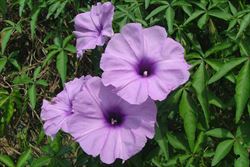
flowers (Photo: Sheldon Navie)
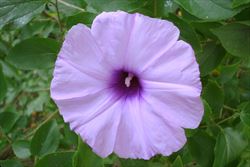
close-up of flower with darker centre (Photo: Sheldon Navie)

the rarer white-flowered form of this species (Photo: Sheldon Navie)
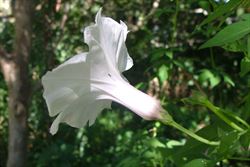
flower from side-on, showing small sepals and narrow floral tube (Photo: Sheldon Navie)
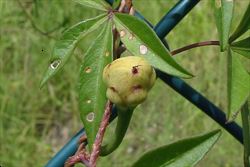
close-up of immature fruit (Photo: Sheldon Navie)

close-up of mature fruit with four seeds (Photo: Sheldon Navie)
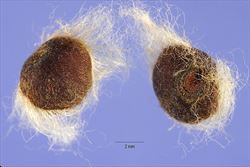
close-up of seeds partially covered in hairs (Photo: Steve Hurst at USDA PLANTS Database)
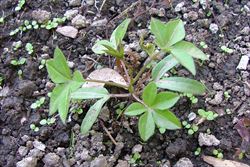
seedling (Photo: Sheldon Navie)
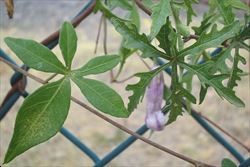
comparison of the leaves of coastal morning glory (Ipomoea cairica), on the left, and white convolvulus creeper (Merremia dissecta), on the right (Photo: Sheldon Navie)

native beach morning glory (Ipomoea pes-caprae) is a coastal creeper with similar flowers, but has quite different leaves (Photo: Sheldon Navie)
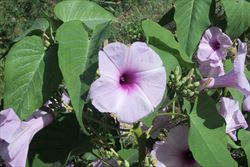
bush morning glory (Ipomoea carnea subsp. fistulosa) is an introduced species with similar flowers, but has quite different leaves and a shrubby habit (Photo: Chris Gardiner)
Scientific Name
Ipomoea cairica (L.) Sweet
Synonyms
Convolvulus cairicus L.Convolvulus pendulus (R. Br.) Spreng.Ipomoea palmata Forssk.Ipomoea pendula R. Br.Ipomoea tuberculata (Desr.) Roem. & Schult.
Family
Convolvulaceae
Common Names
Cairo morning glory, Cairo morningglory, coast morningglory, coastal morning glory, five-fingered morning glory, five-leaf morning glory, ivy-leaved morning glory, Messina creeper, mile a minute, mile a minute vine, mile-a-minute, mile-a-minute vine, morning glory, railroad creeper
Origin
The exact native range of this species is obscure, but it is thought to have originated in tropical Africa and Asia. It is now found throughout the tropical regions of the world (i.e. it is pan-tropical).
Naturalised Distribution
Widely naturalised in the warmer coastal regions of eastern Australia (i.e. in the coastal districts of Queensland and New South Wales). Also occasionally naturalised in the coastal districts of south-western Western Australia and southern South Australia, and on Lord Howe Island, Norfolk Island and Christmas Island.
Also regarded as being naturalised in New Zealand, southern USA, Central America, South America and on numerous Pacific islands (e.g. Fiji, New Caledonia, Niue, the Solomon Islands, Tonga and Hawaii).
Habitat
A weed of waste areas, disturbed sites, rainforest margins, open woodlands, bushland, gardens, fences, coastal sand dunes and vegetation growing near waterways (i.e. riparian areas). It inhabits tropical, sub-tropical and warmer temperate environments (especially near the coast).
Habit
A rampant long-lived (i.e. perennial) climber reaching up to 5 m or more in height, or creeping along the ground.
Distinguishing Features
- a rampant climber or creeper with hairless slender stems.
- its very distinctive leaves have 5-7 finger-like lobes.
- its large purple, purplish-pink or whitish tubular flowers (4-6 cm long and 5-8 cm across) have a darker centre.
- its small capsules (10-12 mm across) turn brown as they mature and contain four seeds.
- these seed are partly covered in long silky hairs.
Stems and Leaves
The slender stems are hairless (i.e. glabrous), grow in a twining habit, and sometimes produce roots at the joints (i.e. nodes).
The alternately arranged leaves (3-10 cm long and 3-10 cm wide) are divided into five or seven narrow lobes, like the fingers of a hand (i.e. they are palmately lobed). These leaves are hairless (i.e. glabrous) and borne on stalks (i.e. petioles) 2-6 cm long.
Flowers and Fruit
The funnel-shaped (i.e. tubular) flowers are purple to pinkish-purple (occasionally white) with a darker purple centre. They are borne singly or in small clusters on short stalks originating in the leaf forks (i.e. axils). These flowers (4-6 cm long and 5-8 cm across) have five petals that are fused into a tube (i.e corolla tube) and five small sepals (4-7 mm long). Flowering occurs throughout most of the year.
The fruit capsules are more or less globular (i.e. sub-globose) in shape and turn from green to brown in colour as they mature. These capsules (10-12 mm across) contain four large brown seeds (about 6 mm across) that are slightly three-angled in shape. The seeds have smooth surfaces interspersed with dense tufts of long silky hairs.
Reproduction and Dispersal
This plant reproduces vegetatively by rooting along its stems and also produces seeds.
Stem fragments and seeds are often dispersed in dumped garden waste and can also be spread by water.
Environmental Impact
Coastal morning glory (Ipomoea cairica) is a significant environmental weed in Queensland, New South Wales and on Norfolk Island. It is also an environmental weed of some importance in Western Australia and on Lord Howe Island, and regarded as a potential environmental weed in Victoria.
This species is capable of very rapid growth and can completely smother trees and understorey plants, but it will creep along the ground in the absence of supporting vegetation. Significant infestations may lead to a reduction in biodiversity through the replacement of native vegetation and the displacement of certain native animals. It is particularly common in the coastal districts of eastern Australia, where it often invades river banks and riparian vegetation. It also commonly invades rainforest margins, where it grows over larger trees and smothers tree saplings and understorey shrubs, and is a major problem in littoral rainforest remnants. However, it is also a weed of sandy beachfronts and other coastal environments, drier forests, wetlands, and limestone cliffs.
Coastal morning glory (Ipomoea cairica) is ranked among the top 30 environmental weeds in south-eastern Queensland, and among the 10 worst weeds in Gold Coast City. This species is actively managed by community groups in Queensland and appears on numerous local environmental weed lists in south-eastern Queensland (e.g. in Redland, Noosa and Maroochy Shires). It is also of significant concern in the coastal districts of northern and central New South Wales, where it also appears on several local and regional environmental weed lists (e.g. in Randwick Shire, Strathfield Shire, Lismore City and Sutherland Shire, on the NSW North Coast environmental weed list, and on the Australian Association of Bush Regenerators environmental weed list for the the wider Sydney and Blue Mountains region).
Coastal morning glory (Ipomoea cairica) has invaded conservation areas in both of these states (e.g. Maroochy River Conservation Park in Queensland and Sturt National Park and Ballina Nature Reserve in New South Wales). It is also thought to pose a significant threat to the bushland reserves in Strathfield Shire, in Sydney, and is listed among the "exotic vines and scramblers" whose invasion of native vegetation is listed as a "key threatening process" in New South Wales.
Remnants of endangered plant communities in New South Wales (e.g. Umina Coastal Sandplain Woodland and Swamp Oak Floodplain Forest) are also thought to be under threat from coastal morning glory (Ipomoea cairica). While on Lord Howe Island, the habitat of the critically endangered Lord Howe Island phasmid (Dryococelus australis) is also thought to be threatened by coastal morning glory (Ipomoea cairica).
Legislation
This species is declared under legislation in the following states and territories:
- New South Wales: Class 4 - a locally controlled weed. The growth and spread of this species must be controlled according to the measures specified in a management plan published by the local control authority and the plant may not be sold, propagated or knowingly distributed (in the Campbelltown, Hornsby, Hunters Hill, Ku-ring-gai, Lane Cove, Manly, Mosman, North Sydney, Parramatta, Pittwater, Ryde, Warringah and Willoughby local authority areas only).
- Western Australia: Unassessed - this species is declared in other states or territories and is prohibited until assessed via a weed risk assessment (throughout the entire state).
Management
For information on the management of this species see the following resources:
- the Biosecurity Queensland Fact Sheet on this species, which is available online at http://www.dpi.qld.gov.au.
- the Strathfield Council weed fact sheet on morning glory species, which is available online at http://www.strathfield.nsw.gov.au.
- the Sutherland Shire Council weed fact on morning glory species, which is available online at http://www.sutherland.nsw.gov.au.
- the Randwick City Council environmental weeds profile on this species, which is available online at http://www.randwick.nsw.gov.au.
Similar Species
Coastal morning glory (Ipomoea cairica) is very similar to common morning glory (Ipomoea purpurea), blue morning glory (Ipomoea indica), ivy-leaved morning glory (Ipomoea hederacea) and white convolvulus creeper (Merremia dissecta). These species can be distinguished by the following differences:
- coastal morning glory (Ipomoea cairica) has hairless (i.e. glabrous) stems and five to seven lobed leaves that resemble the fingers of a hand (i.e. they are palmately lobed). Its flowers are relatively large (5-8 cm across), its sepals are relatively short (4-7 mm long), and it often produces capsules containing four hairy seeds.
- blue morning glory (Ipomoea indica) has hairy (i.e. pubescent) younger stems and heart-shaped (i.e. cordate) or three-lobed leaves. Its flowers are relatively large (7-10 cm across), its sepals are long and thin (14-22 mm long), and it does not produce viable seeds (capsules are generally not seen).
- common morning glory (Ipomoea purpurea) has hairy (i.e. pubescent) younger stems and heart-shaped (i.e. cordate) or three-lobed leaves. Its flowers are relatively large (3-7 cm across), its sepals are moderately long (10-15 mm long), and it often produces capsules containing six hairless seeds.
- ivy-leaved morning glory (Ipomoea hederacea) has hairy (i.e. pubescent) younger stems and heart-shaped (i.e. cordate) or three-lobed leaves. Its flowers are relatively small (3-5 cm across), its strongly curved sepals are long and thin (about 20 mm long), and it often produces capsules containing four to six hairless seeds.
- white convolvulus creeper (Merremia dissecta) has sparsely hairy (i.e. puberulent) stems and five to seven lobed leaves, but each segment is also further lobed or divided. Its flowers are relatively large (4-6 cm across), its large sepals are relatively long (20-25 mm long), and it often produces capsules containing four hairless seeds.
Coastal morning glory (Ipomoea cairica) is also very similar to a native species from northern Australia with palmately lobed leaves that is known as palmate morning glory (Ipomoea mauritiana). However, palmate morning glory (Ipomoea mauritiana) can be distinguished by the fact that its flowers are normally borne in larger many-flowered clusters.

